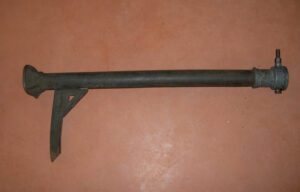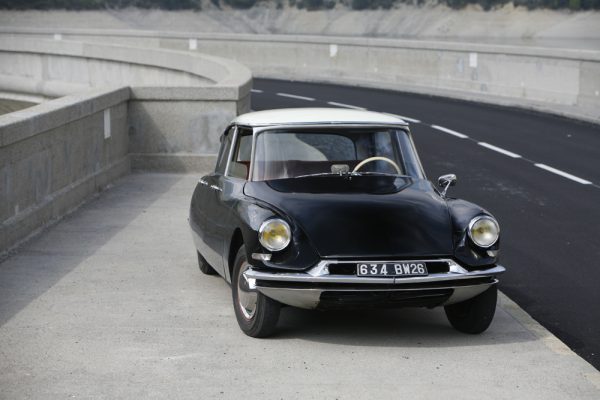KM : 69082 Kms
YEAR: 12/1955
COLOUR: Aubergine AC406
SERIAL N° 32: THE OLDEST DS SOLD KNOWN TODAY.
PRESENTED HERE AS IT WAS AT THE SALON OF PARIS 1955 THE 6TH OCTOBER.
MODEL:
The genius of this car is that it came out in 1955 with the following features:
- Hydropneumatic suspension with ride height correction, whatever the load.
- Power steering, this was extremely rare at the time.
- Hydraulically operated gearchange and clutch (4 speeds on a control near the steering wheel, no clutch pedal).
- Front disc brakes, the first production car so equipped. Furthermore, braking was assisted and brake force was distributed according to the load in the vehicle.
The novel bodywork was also revolutionary:
- Aerodynamics: no front grille, completely smooth underside.
- Visibility: an unrivalled glasshouse, then and even now
- Interior: room to stretch legs in the back
- Comfort: exceptional Dunlopillo bench seats and carpets. Proper heating system, front and rear.
- Safety equipment: single-spoke steering wheel, futuristic plastic dashboard, foot operated parking brake.
- Even the fixation of the wheels with a single central nut was novel.
On the other hand, the engine was a classic 4 cylinder 3-bearing 1911cc motor derived from the one in the Traction Avant, 75Ch at 4,500rpm, used until 1961
This DS has the serial number 32, which corresponds to the 32nd DS ordered.
Its chassis number is 61, which corresponds to the 61st DS that came off the production line.
The difference between these numbers is due to the way the factory was organised to produce cars in batches of colours.
The DS no.32 has a number of details that differentiate it from the 1.455 million produced. Its evolution continued during the 20 years of production, here are the first and most obvious detail differences:
- The assembly lines were not completed until February 1956. This DS was assembled entirely by hand. Thus most of its mechanical components and body parts were numbered by being hand struck.
- In common with the first 200 or so cars produced, it does not have a ride height control lever (this appeared in February 1956). So there are no studs on the longerons and no holes in the longeron coverings. Changing a wheel was by a traditional jack.
- A lock was only present on the right front door (absent on the left), just like on a Traction Avant, up to May 1956. Not very convenient!
- The steering wheel was wrapped in vinyl thread before being wrapped in tape from April 1957.
- The front lower bodywork was embossed up to May 1957.
- The exhaust was central and finished in a ‘carp tail’ trim up to February 1958.
- The reflector trim on the rear wing had a red stripe, until May 1958.
Production for the year in 1955: 175 cars
Price at the time: 930,000 old Francs = 1,417 Euros
Minimum monthly wage at the time: 21,839 old Francs = 33 Euros
HISTORY:
On 6th October 1955, in the first few minutes of the opening of the Salon (show), the
director of the foundry of Bourg Les Valence was the 32nd person to order a DS. 12,000 firm orders were taken throughout on the first day, 80,000 during the whole time of the Salon. The assembly line did not start until November. The car was delivered on 19th December by the dealership Minodier in Valence, under the registration plate 634 BW 26 which it kept throughout its history (see the copy of the prefecture archive records).
After a year and a half of use and a number of hydraulic problems, it was taken back by the Minodier garage on 21st June 1957 with 10,000km on the clock.
Savel, one of the mechanics, prepared the DS for sale for a second time. In June 1958, a grocer from Valence, Mr Maisonny placed an order for a 2CV van. At that time, it was common to have to wait several years for delivery of a new 2CV. He was advised that the waiting time would be reduced if he also bought a second-hand car. He therefore takes on DS no.32, which had been lingering for a year in the dealership. He would go on to use it for leisure and for long holidays in the Var. The rest of the time, it would be kept in a garage.
By 1970, it had covered 32,000 km. Mr Maisonny decided to buy a new GS. These first GS’s were eagerly awaited, with customers lining up to place an order. Citroen-Valence only offered him 100 Francs for this old uninteresting DS. Our offended grocer declined the offer. He kept the DS with no further use until he sold the premises. In March 1984, he asked the Valence dealer, Mr Galeris, to find him a buyer for the DS.
At that time, Mr Kaminski, former director of the Lyon dealership, had just taken over the Romans dealership. He had made the trip in a Traction 15/6, which had attracted the
attention of his colleague Mr Galeris, who thought of putting him in contact with
Mr Maisonny. A deal was struck for the sum of 14,000 Francs.
Mr Kaminski sorted the leaking issues that followed the period of immobilisation and
resprayed it, in order to display it alongside an SM in his garage in the centre of Romans (see photos). It was repainted black in error, when its original colour was Aubergine.
Having learned of the existence of the DS in 1985, I went to this old dealership, but Mr. Kaminski did not want to sell then. I came back and offered him an exchange for my
convertible of the same era. The refusal was less categorical, and he took down my contact numbers.
In the summer of 1991, I was working in Norway and his call to my landlines went unanswered. And so it was a Dutchman, Martin Boersma, who got to take the car on the road as far as Eindhoven. He also had a DS convertible that he sold to buy this gem (140,000 Francs).
In the Autumn of 1991, I closed my restaurant in Oslo and passed through Romans, and found only the SM was on display. I contacted Martin who explained that he had opened a museum with thousands of DS models and this was the only full size car. He never drove it again and it was not for sale at the time.
In December 2004, Martin called me, as he had decided to sell it. I brought it back on a flatbed to its country of origin, it would be my best ever Christmas present. I became the 4th and final owner.
To my delight, it was never registered in Holland and so kept its registration plate from its very first day. After this very long period of immobilisation, the mechanical parts were seized. I had to revise everything ready for a road-test carried out by Auto-Journal for the 50th Anniversary of the DS (attached here). Ever since, I review and take it out every Autumn when the museum is closed. Finally for the 70th anniversary of the DS, it takes back its Aubergine colour from its first day.
Le cric des premières DS

En l’absence de commande manuelle de hauteur, le changement de roue s’effectue de façon classique (style 2CV), en plaçant le bras de ce cric dans un des 4 carrés de la caisse prévus à cet effet. Ces derniers ont d’ailleurs existé jusqu’à la fin de la production. Leur présence était utile en atelier, car on pouvait y placer une rallonge qui servait de point d’appui pour soulever la DS.
La commande manuelle de hauteur apparaît en février 1956, donc peu de voiture ont été munies de ce cric, on en connaît 3 aujourd’hui, la n°191 de Mr TAFFIN, la ELV 31 et la 32.
Il se rangeait sur l’aile avant droite, une patte sur le porte bidon et un carré permettaient sa fixation. Michel LEFEBVRE du bureau d’étude de l’époque m’a signalé une anecdote à ce sujet. Lors d’un essai sur une EL, ce cric était tombé de son emplacement pour venir bloquer la barre de direction. Il avait signalé ce problème et fait placer (sur les modèles à commande de hauteur) la barre et sa manivelle sous la roue de secours.

